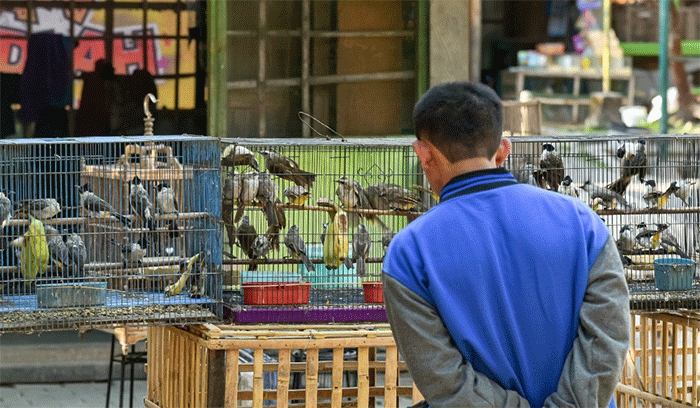New Global Analysis Reveals Why Some Birds Enter Trade and Others Don't
Analysis of more than 9,000 species shows that the birds humans find most visually appealing are also the most likely to appear in domestic and international markets.

A global analysis of bird trade
A sweeping new study has revealed a clear and troubling pattern: the more visually appealing a bird is to human eyes, the more likely it is to end up in wildlife trade. Scientists analysed 9,228 species and found that aesthetic value – the colours, shapes and features people admire – is a significant predictor of whether a species is traded.
Drawing together five major datasets on legal and illegal trade, the research team found strong evidence that global markets consistently target species with high aesthetic scores. These scores, derived from a worldwide questionnaire involving more than 6,000 participants, capture how humans intuitively judge a bird’s appearance.
While trade is shaped by many factors, the link with beauty was stronger and more widespread than previously documented, extending well beyond brightly coloured parrots and songbirds to include owls, raptors and other groups.
Attractive birds dominate the international live bird trade
The strongest association between beauty and trade emerged in the international live bird market. Species with high aesthetic scores were far more likely to appear in cross-border trade, much of which is driven by demand for pets and display birds.
Large, colourful or visually distinctive species – long-tailed birds, crested species, and those with unusual plumage patterns – were particularly prominent. International markets appear to be especially sensitive to visual appeal, with buyers selecting species for their uniqueness or ornamental qualities.
Domestic live trade showed a similar pattern, though the influence of beauty was weaker, suggesting that local markets may be shaped more by cultural or practical considerations, including tradition, accessibility and willingness to handle certain species.
Not all trade is about appearance
When it comes to bird products rather than live birds, the influence of aesthetic value varies. International trade in decorative derivatives – such as feathers, ornaments and trophies – still showed a positive link with beauty. But domestic markets told a different story.
Here, species traded for meat, bones or medicinal uses were often those with lower aesthetic scores, indicating that functionality rather than appearance was the key driver. In fact, the study detected a negative relationship between beauty and domestic trade in non-aesthetic derivatives.
This contrast highlights the complex web of cultural, economic and practical forces that shape how different societies use bird species.
Range size, body size and availability also matter
Alongside aesthetic value, two other factors strongly predicted whether a species is traded: range size and body size.
Birds with very large or very small ranges were more likely to appear in trade. Species with broad distributions are simply easier to encounter and harvest. Conversely, some range-restricted species may become desirable because rarity can increase perceived value.
Body size had an intriguing dual effect. Larger species were more likely to be traded internationally, while smaller species were disproportionately represented in domestic live markets – likely reflecting ease of transport, handling and the practicality of keeping small birds in the home.
Europe’s trade patterns differ from global trends
A separate analysis of European Union trade – shaped by long-standing bans on wild bird imports – revealed a more complex picture. Here, high aesthetic value did not strongly predict live bird trade, as both attractive and plain species appeared in seizure records.
Many of the traded species in the EU were lower-value species taken domestically for food or cultural practices, illustrating how regulatory frameworks can reshape market composition.
The findings underscore the need to examine trade dynamics at regional scales, where enforcement, culture and opportunity can drastically change which birds enter the market.
When beauty becomes a conservation risk
The study’s conclusions carry clear implications for conservation. Of the world’s threatened bird species, many are valued in trade specifically because of their striking appearance. Understanding aesthetic drivers can help identify species likely to be targeted in future – even before trade is detected.
As markets shift and global demand grows, visually distinctive species may face increasing pressure. Conservation strategies that anticipate these risks, rather than react to them, could help prevent overexploitation before it becomes severe.
The authors argue that identifying species with high aesthetic appeal may be as important as mapping rarity or tracking illegal shipments, offering a new predictive tool for regulating or monitoring trade.
A new lens on wildlife trade
By combining behavioural data, biological traits and trade records at unprecedented scale, this research highlights the profound influence of human taste on wildlife markets. Beauty – however subjective – is now recognised as a measurable factor shaping global exploitation patterns.
For conservationists, this raises both challenges and opportunities. The very qualities that make birds so captivating to humans can also place them at risk. But by understanding these preferences, it may be possible to act earlier to prevent demand from spiralling into decline.
In short, our admiration for the natural world continues to shape it – sometimes in ways that carry a heavy cost for the species we cherish most.
November 2025
Read the full paper here
Get Breaking Birdnews First
Get all the latest breaking bird news as it happens, download BirdAlertPRO for a 30-day free trial. No payment details required and get exclusive first-time subscriber offers.
Share this story







